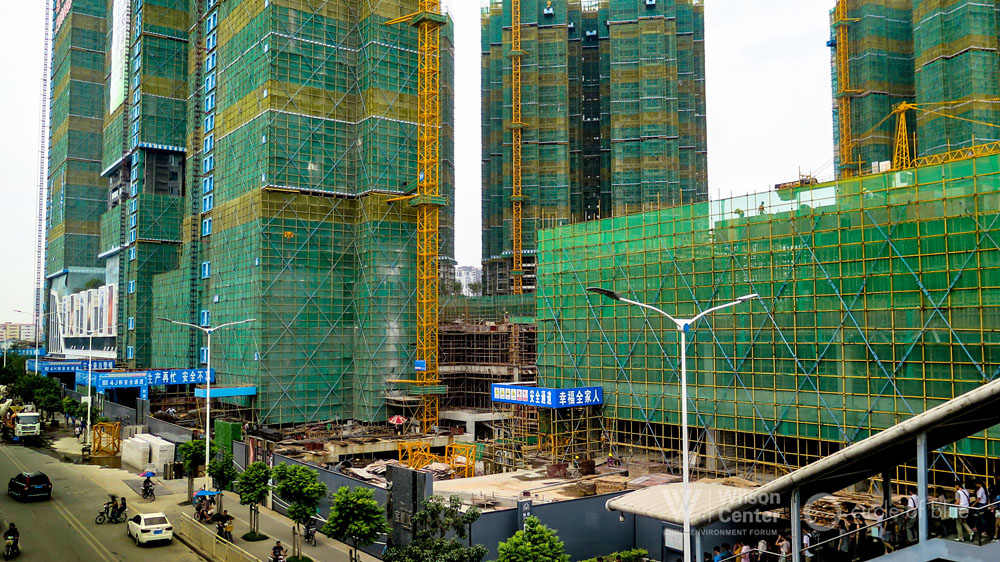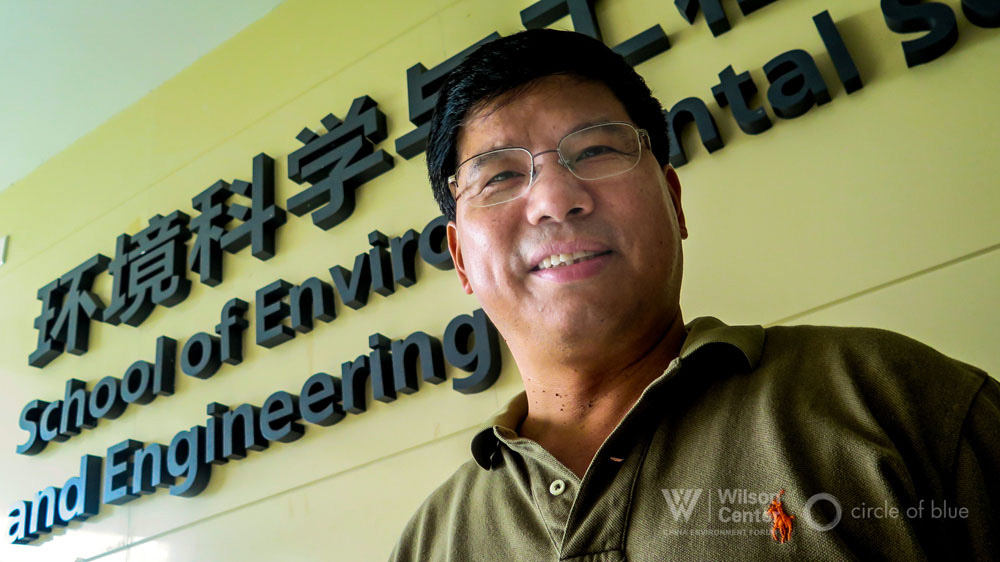-
In Shenzhen, Tracking the Early Steps of China’s Carbon Pivot
November 18, 2015 By Keith SchneiderSHENZHEN, China – To some extent, the contemporary industrial age is a global narrative of substance abuse and recovery.
SHENZHEN, China – To some extent, the contemporary industrial age is a global narrative of substance abuse and recovery.
Sixty years ago the basic elements at the center of political and ecological concern were uranium and plutonium. Reckless Soviet and American atomic bomb blasts put so much deadly radiation in the atmosphere that milk and water became contaminated. Nations heeded the warnings of scientists and a global treaty to ban atmospheric testing was signed in 1963.
In the 1970s and 1980s the world came to recognize the malignant hazards of chlorine and its various compounds, used to manufacture pesticides, plastics, and coolants. A hole in the ozone opened over Antarctica. An industrial accident in Bhopal, India, killed thousands. Trace residues showed up in food, breast milk, and groundwater. Chlorine-based products were banned. Cleanup programs were instituted. Industrial safety improved.
Today, the world is steadily coming to agreement that carbon is the chemical compound putting life and economies at risk. Rejecting the views of the fossil fuel industry and their political allies in the United States, most national governments now heed the warnings of scientists about the climate-altering capability of carbon and are pivoting away from fossil fuel, its principle source.
Shenzhen could become the model for a national emissions trading marketAs part of our Global Choke Point project, the Wilson Center’s China Environment Forum and Circle of Blue are closely studying trends in energy and water supply and use in two Pacific port cities: Shenzhen, China, and Oakland, California. The Choke Point: Cities project builds on five years of multimedia reporting and convening that examined the water-energy-food confrontations in China, Australia, the United States, India, Mongolia, and the Arabian Gulf.
Like other port cities, Shenzhen and Oakland are growing and face tightening water and energy choke points that have prompted differing consequences. Shenzhen only recently started to tilt to cleaner, less water-consuming energy development. Oakland, we found earlier this year, is among the leaders in the United States in energy efficiency, water conservation, and alternative energy production. The city’s municipal wastewater treatment plant, for example, processes organic waste to generate most of its electrical power demand.
Choke Point: Cities also includes a U.S.-China research exchange that next spring will convene research and policy stakeholders from both countries to write briefs, discuss solutions, and work to identify areas of U.S.-China collaboration.
A Change in Tone
Amidst the global awakening to an era of ecological and economic reason, China’s reckoning with the dangerous consequences of carbon stands out. With an estimated 8.5 billion to 10 billion metric tons of CO2 emissions annually, China produces more of the world’s carbon air pollution than any other nation. With new sensitivity to that development, China reached agreement with the United States to cap its coal consumption and emissions by 2030 a year ago.
Here in southeast China, the Central Government, the United Kingdom, and the executive offices of large Chinese utility and oil companies are collaborating on an experimental project to capture carbon from a new coal-fired electrical generating station outside the Pearl River Delta and permanently entomb it in old oil wells in the South China Sea.
The new carbon capture and storage project fits in among many other pollution prevention and emissions reduction measures that have taken effect in the Pearl River Delta, home to 60 million people. Shenzhen’s municipal leaders today talk at length about their responsibility to switch development to greener and cleaner industries. This city’s economy is shifting from manufacturing to cleaner information technology businesses, software development, and professional services.
Provincial and municipal governments outlawed new coal-fired power plants earlier this decade and ordered existing coal-fired generating stations to convert to cleaner natural gas. Outside the delta, the Guangdong provincial government requires new coal-fired plants to be constructed with globe-leading operating efficiency and lower emissions levels comparable to natural gas-fired plants.
The Guangdong provincial government last year approved a two-year, $3.6 billion program to accelerate development of an estimated 25,000 megawatts of wind power, most of it offshore. Nearly $2 billion is to be spent on solar power. And the energy development program includes $17.6 billion for seawater-cooled nuclear plants. No public investment is planned for coal-fired plants.
Other carbon-reducing initiatives include bus fleets propelled by batteries, overhead electric lines, and natural gas. These operate in Guangzhou and Shenzhen, the province’s two largest cities. Some of the tallest, most energy-efficient office towers in the world have been completed or are under construction in both cities.
Two new carbon emissions trading markets, intended to eventually reduce carbon emissions, operate in Guangzhou and Shenzhen. Either could become the model for the national emissions trading market that China’s President Xi Jinping announced in September during his visit to Washington.
The coal cap, carbon sequestration, fresh investment in cleaner alternatives, and intensifying focus on energy efficiency and emissions trading markets are unmistakable changes from the disdain that Chinese officials expressed for environmental values as recently as 2010 when the Wilson Center and Circle of Blue began the “Choke Point: China” project. At the time, domestic and international concerns about the country’s dangerous air pollution, climate change, or the risks that coal production and use presented for water supplies and quality were dismissed as interference in China’s development.
Oarsmen, Pulling Against the Current
The carbon emissions and pollution reduction measures in Shenzhen are also intended to attract young and educated entrepreneurs.
Xi Liang, a 33-year-old finance and energy policy expert who was raised in the Pearl River Delta and trained in the United Kingdom, is one of the young people leading the country’s shift on carbon. Two years ago he helped to found, and became the secretary general of the UK-China CCUS Center, a bilateral collaborative project to develop ecologically safe and economically affordable techniques to capture and sequester large amounts of CO2 from power plants.
Liang is among the senior managers of a carbon capture demonstration project being installed in China Resources Power’s new Shanwei Haifeng generating station in Xiaomo, a fishing port of 13,000 residents along the South China shoreline east of Shenzhen. The first of the plant’s 1,000-megawatt generators opened earlier this year. Engineers are designing three technologies to capture 50,000 metric tons of carbon dioxide annually from the seawater-cooled plant’s exhaust, Liang explained.
What is driving China’s emerging urgency about carbon, Liang said, is a potentially ruinous economic and ecological race with the hazards of coal that the world’s largest nation could very well lose.
“We have a limited amount of time,” said Liang in an interview with Circle of Blue in Guangzhou, where the UK-China CCUS Center is based. “We have to develop alternatives. We have to learn how to de-carbonize fossil fuels. If we cannot find a way to reduce emissions then we have to make a decision about what we are going to do. People in China live with the terrible air pollution. Our emissions affect the world. China understands that.”
“How much time is left in the world’s carbon budget?”China also recognizes that its coal endowment fueled the rapid development of an economy now valued at nearly $11 trillion annually, second only to the United States. China’s coal production, which Chinese authorities revealed in October is nearly 20 percent higher than previously disclosed, is four times the production of the United States, the second largest producer. Coal is processed for chemicals and liquid fuel, and combusted for heat, electricity, steel, glass, and cement. Though China is diversifying its energy production by constructing the world’s largest non-carbon energy sector – wind, solar, hydropower, geothermal power, and nuclear energy – coal is still projected to supply more than 70 percent of the nation’s energy demand for decades.
Those in China’s clean energy sector are like oarsmen pulling hard against a current, says Liang. For the time being, the authorities display every intention to continue mining and using their domestic coal reserves. Somehow, some way, China needs to develop technology and practices to limit the damage, says Liang. He describes his group’s goal with a healthy amount of righteous zeal.
“In China we say a journey of a thousand miles starts with the first steps,” said Liang. “First you need to demonstrate that the technology works. You need to give government and industry the confidence and the understanding of how much it costs. For carbon capture, it takes three years to develop the technology. For storage to be credible, it takes 5 years, maybe 10 years to prove it works.
“If you talk about global climate agreement in 2020 or 2025, it’s not too early to develop a large-scale project like we have here. We have funding and policy support for a large-scale project. This is the first project in South China. To get 20 more, or a few hundred more, it will take another 10, 20 years. How much time is left in the world’s carbon budget? We’re not sure.”
Will Carbon Capture Ever Have Its Time?
Just as significant as how long China can continue emitting carbon at such high levels, is whether capturing and storing carbon from power plants will really make any difference in slowing climate change.
“Capturing CO2. It’s very hot in the U.S.,” said Chunmiao Zheng, professor and dean of the School of Environmental Science and Engineering at South University of Science and Technology of China, in Shenzhen. “In China we are talking a lot about it too. But in China more people realize it’s not going to make a big difference because we are producing so much CO2. It’s costly to capture and it’s a small part of total emissions. We have to think of some other way.”
In Guangzhou, Liang and his colleagues take a different view. They are convinced that carbon capture and storage are at least part of the solution. The gas captured at the Shanwei Haifeng power plant is meant to pressurize old wells and increase production in a waning China National Offshore Oil Corporation oilfield in the South China Sea. Engineers are studying the deep geology of the oilfield and working their way to suggesting a suitable well for carbon dioxide disposal. According to Liang, Chinese-built ships will transport 250,000 metric tons of CO2 annually from the demonstration project to the well.
If the early steps are successful, China Resources Power executive say they are prepared to install the technology on unit three of its new plant and transport 1 million metric tons annually, by pipeline, to the offshore oilfield. That represents 15 percent of the new generator’s annual CO2 emissions. The new 1,000-megawatt generating unit has not yet been approved by Guangdong Provincial authorities.
The risky and expensive Shanwei carbon capture and storage project is among the first to try using offshore oil wells as a repository for carbon. The Global CCS Institute, an Australia-based trade group, reports that 15 industrial-scale carbon capture and sequestration projects are operating around the world, but there are no thorough studies about the hazards of transporting large amounts of carbon dioxide by ship or pipeline to be pumped under pressure into deep geological spaces beneath the sea.
The first large carbon capture and storage project attached to a power plant began operating last year in Saskatchewan, Canada. Shell is close to finishing a $1.35 billion project to capture and store 1 million metric tons of carbon dioxide from its tar sands refining plant in Alberta, Canada. Southern Energy is finishing a 582-megawatt coal-fired plant in Mississippi that is designed to capture and store 3.5 million metric tons of CO2. The nearly $6 billion power plant is years overdue and more than $3 billion over budget, according to a research group at the Massachusetts Institute of Technology.
A Sea Change Coming
Scientific interest in capture and storage dates to the 1970s. And CO2 produced from natural geologic sources has been used to recharge old oil fields for decades. The small surge in industrial and demonstration projects in the United States, United Kingdom, and China embodies the national and industrial interest in perpetuating coal consumption by preventing carbon from doing more environmental damage.
But the fate of carbon capture and storage technology is troubled. Its potential risks are not yet well understood. And its cost will push coal-fired power to prices above those for cleaner alternatives, which are now competitive with energy from conventional coal-fired plants.
And then there is the imperial power of history and precedent. In the 1990s, the global chemical industry backtracked from their assurances of safety when waste products were discovered to be seeping into surface and groundwater reserves all over the world. In very short order, companies altered production practices, changed product lines, and cut waste and pollution at the source to sharply reduce health and ecological risks. Today, the flight of the atom seems doomed amid the insipid risks of radioactive fallout, crippled nuclear reactors, and most recently the Fukushima disaster.
Not long ago, the hazards of carbon were seen as whimsy in the United States, China, and a good portion of the developed world. How quickly that view is changing.
In the United States, in an especially telling example of the global shift on fossil fuels, President Obama in early November rejected the Keystone XL oil pipeline, and Exxon Mobil is being investigated for securities fraud. The world’s fifth largest company by revenue is charged with hiding its own scientific studies about the threats associated with carbon emissions and spending millions to protect its fossil fuel holdings by supporting lawmakers and interest groups that marketed the false idea that climate change is a scientific hoax.
In China’s Pearl River Delta, Liang and others like him continue to pull against the current, but it is perhaps not as strong as it once was.
Keith Schneider is senior editor and chief correspondent at Circle of Blue and helped develop the Global Choke Point project. A two-time winner of the George Polk Award and other honors for his work, he also reports on energy, agriculture, the environment, and policy for The New York Times, where he has served as a national correspondent and contributor since 1981. Reporting assisted by Evana Su.
Sources: Circle of Blue, Edmonton Journal, European Commission, Global CCS Institute, Massachusetts Institute of Technology, The New York Times, PBL Netherlands Environmental Assessment Agency, RenewableEnergyWorld, The Washington Post, The White House.
Photo Credit: Keith Schneider/Wilson Center/Circle of Blue.
Topics: adaptation, Asia, China, China Environment Forum, Choke Point, Choke Point: Port Cities, climate change, coal, consumption, cooperation, development, economics, energy, environment, environmental health, featured, global health, international environmental governance, mitigation, natural resources, oceans, solar, U.S., urbanization, wind, youth
 A Publication of the Stimson Center.
A Publication of the Stimson Center.










